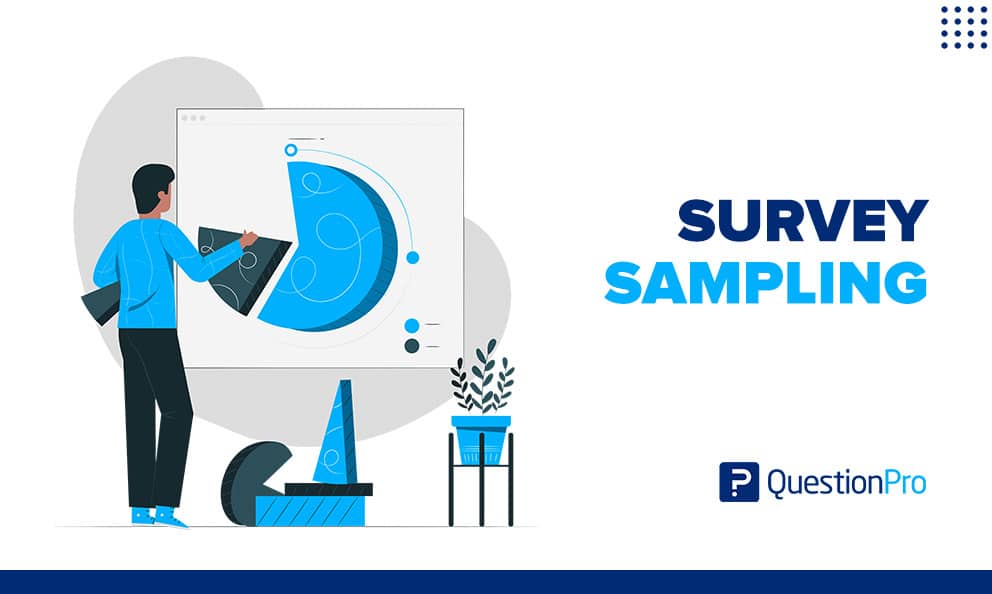
Let’s say you wanted to do some research in Europe. Asking every person in that region sounds impossible, right? Even if everyone said “yes,” carrying out a survey across different countries, languages, and time zones, collecting and processing all the results would take a long time and be very costly. The data can be collected more quickly and save time a lot from survey sampling.
Survey sampling is a process where researchers collect data from a representative sample of their population or study participants.
A representative sample is representative of the population at large – it includes enough people who represent their target population to provide reliable information about what they think or believe.
In other words, if you counted up all of the people in your country and asked them for their opinion on a certain topic, you wouldn’t know if they were representative of everyone in that country because not everyone would be able to answer your questions (because they might not have access to the internet).
What is survey sampling?
Survey sampling is a procedure within the design of an investigation through which data is collected through tools such as questionnaires or surveys.
Sampling helps a lot in research. In survey research, sampling refers to how we select members from the population to be in the study. It determines the accuracy of research/survey results.
The principle of a sample survey is not to observe the entire population studied but rather a properly selected subset, called a sample.
LEARN ABOUT: Purposive Sampling
Why do researchers need survey sampling?
This sample is usually much smaller than the population considered. This advantage makes it much easier to operate than in an exhaustive survey. Survey sampling methods are the ways that a small group of people or units are chosen from a bigger population so that a survey can be done.
To obtain faster results at a much lower cost and to have better quality data, it is possible to collect data much more carefully when dealing with a small number of subjects than when interviewing and/or examining an entire population.
Types of survey sampling:
Researchers have different types of survey sampling at their disposal, each one with special characteristics that allow it to be adapted to specific circumstances. Below we mention the most popular ones so that you can identify which one could be for you to use in your next big research project.
Probability sampling methods
A non-probability sampling procedure is a method of selecting members of a population in which every member of the population does not have an equal chance of being chosen.
This is more common than non-probability sampling because it allows you to make meaningful conclusions about the population being studied by using statistical surveys. Stratified sampling and cluster sampling improve the precision and efficiency of probability sampling without changing its core principles.
Simple random sampling
Simple random sampling is a way of selecting a sample that has the same chance of being selected as any other member or set of members in the population. It does not matter how often you use this method to draw samples—you will get the same result each time.
Cluster sampling
Cluster sampling is a method of selecting respondents that involves selecting groups rather than individual units of the target population. The groups might be pre-existing, such as people in specific zip codes or students belonging to an academic year.
Cluster sampling is commonly used when it is difficult or impossible to obtain information about individual members of the target population. For example, if you want to study the well-being of high school students but can only gather data about their schools, cluster sampling would be appropriate for your research.
Non-probability sampling methods
Non-probability sampling is typically used when you don’t have a specific target population to work with. You’re looking for any type of data that will help you in your research or project, but you don’t have any specific population parameter in mind.
In this case, it’s important to ensure that your sample represents the larger group you’re trying to represent. You want your sample to be as diverse and varied as possible so that the results of your study can be generalized to the larger group.
Quota sampling
A non-random method is the opposite of a random method. In a random method, the researcher does not specify which people or key factors to select, whereas, in a non-random method, the researcher is clear about who or what will be included.
Snowball Sampling
With this approach, people recruited to be part of a sample are asked to invite those they know to take part, which are then asked to invite their friends and family, and so on.
QuestionPro offers the market’s most powerful online survey software, choosing sample method, sample size, and survey length. This Survey software allows you to choose from various sample methods.
One of the most important aspects of conducting a survey is ensuring that a given sample is representative of the entire population. It is critical to recruit respondents that accurately represent the core demographics of your target population.
With every QuestionPro survey, you can conduct a questionnaire analysis to ensure that your survey sample is representative of your target population.
How to use your survey sampling
In conclusion, it can be said that using a sample in research saves mainly money and time; if a suitable sampling strategy is used, an appropriate sample size is selected. Necessary precautions are taken to reduce sampling and measurement sampling errors, and then a sample should yield valid and reliable information.
In addition, the researcher must ensure that the sample is representative of the population from which it was drawn. This can be done by applying appropriate sampling methods that provide a suitable measure of representativeness for each measured variable.
Now that you know who the survey participants are for your survey, the next step is to find people who meet the necessary criteria, meet the profile, and the necessary fee to validate your research.
Platforms like QuestionPro have services where you can easily access more than +123,000 million people and segment them according to your research needs.
Frequently Asking Questions (FAQ)
Expanding the sample size reduces sampling errors. The sample gets closer to the population as the sample size increases, reducing the chance of deviations.
Survey sampling allows you to collect data on a representative sample of your target demographic. This is why it’s so important.
Non-probability sampling frequently produces biased samples because some individuals are more likely to be included than others.







